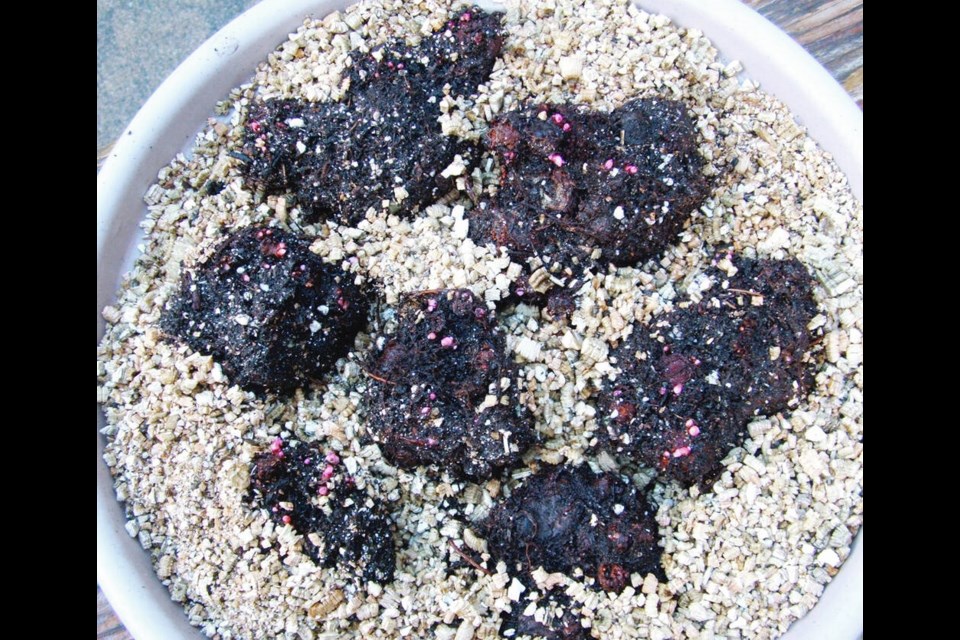Dear Helen: Should I be taking my begonia tubers out of cold storage now? They are the hanging basket type of begonia, ones I grew for the first time last year.
L.B.
Storage temperatures between 5 and 10 C usually keep the tubers from sprouting all winter, but they do need to be checked often through the winter to make sure they are not either shrivelling or developing any mould.
Begonia tubers in cold storage could begin producing tiny pink nubs of growth any time now. Check often, and if no signs of life appear, bring the tubers into the house in the first week of March.
Nestle them into a bed of an indoor plant potting mix or lightly dampened vermiculite, spray-mist the tops and place them in warmth. With the appearance of pink growth nubs, the tubers can be potted, individually or in shallow communal containers. As leafy growth develops, place the pots in bright indirect light and in coolish temperatures for sturdy, stocky growth.
Plant the begonias in their hanging baskets for placing outdoors around tomato transplanting time, that is when overnight temperatures no longer dip below 10 C.
Dear Helen: I see lichen on some of my fruit trees and also on the boards of my wooden fence. Should I scrape it off?
L.F.
Not on the trees. Scraping will harm the bark. Lichens are not parasitic and are not considered harmful to trees unless the growth is prevalent and thick enough to impede normal respiration in the tree. Late winter spraying with lime-sulphur, before growth buds open and during dry, frost-free weather, helps to clean off the lichen, which grows where the air is clean, and free of sulphur compounds.
Check the label carefully and follow safety directions. Protect eyes and skin. Make sure the spray is suitable for your target trees.
Thinning to open up tree canopies and allow improved air circulation and penetration of light to all parts of the trees is one of the best ways to cultivate health in fruit trees.
If you find the fence board lichen growth unsightly, it can be removed with a wire brush. Two years ago a friend offered to clean away some of the lichen on my front fence. At my local hardware store I found wire brushes of different sizes, some narrow for scraping in narrow spaces. They worked well to remove the lichen. The removal did improve the appearance of the fence.
Dear Helen: Last year, for the first time, some of the leaves on my sweet bay (Laurus nobilis) tree developed thickened, discoloured and curled leaf tips. What caused this and how can I prevent the problem this year?
L.D.
I’ve had a similar issue on my bay tree, and a recent visitor in the garden noted she has seen the same damage on her bay tree. The cause is an aphid-like, sap-sucking insect known as the bay tree sucker.
Adults winter over under shelter and emerge in the spring, to feed on the leaf margins and lay eggs inside the leaf curls the feeding creates. The eggs hatch into larvae covered in white fluff. The larvae continue feeding and distorting the leaf margins from spring through early autumn. There can be several generations of the pest over this period.
Radical hygiene, pruning, and predator protection are major controls. Keep all prunings and fallen leaves picked up. Clean the surrounding ground of debris and other sheltering materials. Through the spring and summer remove and destroy affected leaves.
Prune to relieve congestion and allow free circulation of air and penetration of sunlight to all parts of the tree.
Protect the birds, ladybirds and ground beetles that are the natural controls of this pest by avoiding the use of pesticides.
VHS meeting. The Victoria Horticultural Society is hosting a Zoom meeting on Tuesday, March 1, from 7 to 8:30 p.m. The featured speaker will be Dr. Patrick von Aderkas, a professor in the Centre for Forest Biology at the University of Victoria. He will lead participants on a virtual tree walk of Victoria, just in time for spring walks to appreciate the weird and wonderful assortment of trees that tower above us. Drop-in fee for non-members is $5. To register, visit



